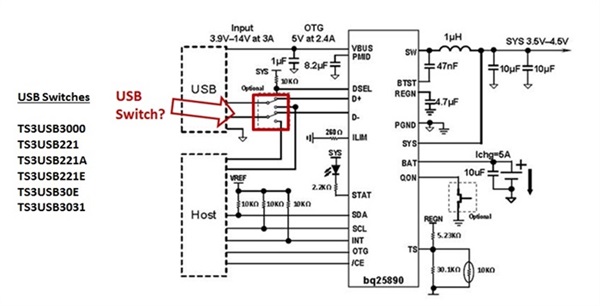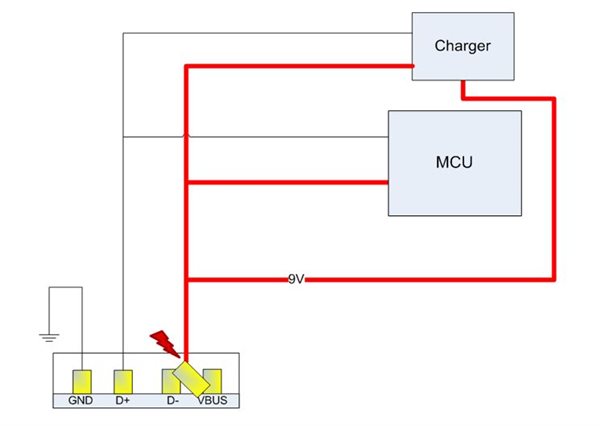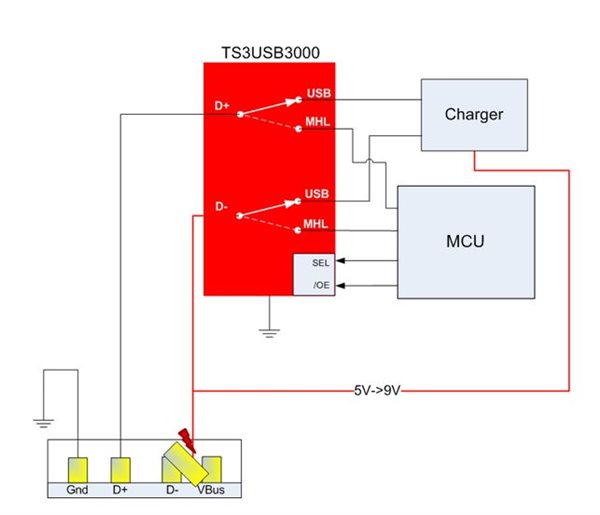SSZTBE7 April 2016 BQ25890 , TS3USB3000
This post is co-authored by Matthew Xiong.
Portable electronic point-of-sale (EPOS) devices are becoming more and more popular worldwide. Portable EPOS devices, unlike traditional countertop devices, have a finite battery life and need constant recharging via USB interface or some other connector.
Since fast charging technologies are gaining a lot of traction in the portable electronics market, it is likely that portable EPOS devices will be adopting such a feature. As portable devices go to bigger batteries, more power from the charging adapter will be necessary to allow fast charging. Different manufacturers have proposed several methods, but every method requires a higher input voltage at the power connector. A higher input voltage allows more power into the system for fast charging without increasing the current above the connector’s limited current-carrying ability. The adapter voltage default setting is the usual 5V (USB VBUS) level, but signaling on the D+/D- data lines between the external adapter and the mobile device can negotiate the adapter output higher as needed. Typical values include 5, 9, 12 or 20V output levels depending on the adapter capability. The charging integrated circuit (IC) or application processor in the system controls this signaling so that the adapter voltage only goes to the appropriate level.
Typically, when inserting the USB connector, you need an analog switch to transmit power between the microcontroller unit [MCU]) and a battery charger like the bq25890 fast charger with MaxCharge™ technology, as shown in Figure 1. Upon first connection, the MCU has control of the D+/D-. It will detect whether it is a charger or a USB attachment.
 Figure 1 Typical Application Diagram
for an Application Using USB and a Charger
Figure 1 Typical Application Diagram
for an Application Using USB and a ChargerThe signal passing through a USB connector may be routed to different destinations depending on what is connected. A USB switch is required to properly route the signal. In this case, any USB switch that matches the bandwidth, configuration, voltage range of the design can be used. TI provides multiple USB switches that cover a wide spectrum in terms of configuration, voltage ranges, on-resistance (RON) and bandwidth.
Application processors cannot tolerate high voltages. Since fast charging generally operates at 9V and the MCU cannot tolerate 9V, it becomes crucial that the MCU is never exposed to this voltage.
The USB connector receptacle has four pins – VBUS, D-, D+ and GND – shown from right to left in Figure 2. After negotiating the fast charge state, the VBUS will be at 9V.
 Figure 2 USB Switches and Pin
Descriptions
Figure 2 USB Switches and Pin
DescriptionsA USB plug not inserted properly or removed at an angle when VBUS equals 9V might cause the VBUS pin to short with the D- pin of the connector. This exposes the MCU connected to the D- pin to VBUS, damaging the MCU, as shown in Figure 3.
 Figure 3 The Consequence of Not Using
the TS3USB3000 At 9V When a Short
Happens
Figure 3 The Consequence of Not Using
the TS3USB3000 At 9V When a Short
HappensThe TS3USB3000 USB switch protects the MCU at 9V while enabling switching between the MCU and the charger/universal asynchronous receiver/transmitter (UART), as shown in Figure 4. After connecting a charger to the USB port, the MCU will detect the attached charger and pull the output enable (OE) pin high to disable the switches. The MCU will communicate to the charger that it can negotiate for a faster charging mode with VBUS at 9V, also shown in Figure 4. The TS3USB3000 is now in a low-power state, with the switches disabled and can protect the MCU.
 Figure 4 The TS3USB3000 Protects the MCU at 9V When a Short
Happens
Figure 4 The TS3USB3000 Protects the MCU at 9V When a Short
HappensThe TS3USB3000 switch serves two purposes: it switches between the host and the charger, and it protects the MCU from 5V to 9V. For the first purpose, you can use any USB switch, depending on what kind of bandwidth and RON your design requires. But for the second purpose, a specialized USB switch like the TS3USB3000 is needed to protect the MCU from a short.
The TS3USB3000 serves these two purposes for designs that need to operate at 9V. The device makes switching between the host and MCU easy, and if a short between the VBUS and D- occurs while inserting or ejecting the USB connector, it protects the MCU.
What challenges do you face when designing battery-powered industrial devices or other USB applications? Log in to post a comment below or join the USB forum.
Additional Resources
- Learn more about TI USB switches.
- See the TS3USB3000 data sheet.
- For similar tips for smartphone and other personal electronics design, read the Analog Wire blog and learn how to “Protect your application processors from short circuit at 9V”.
- Watch the video “9V Fast Charging Protection Application with TS3USB3000”.
- View all TI Designs reference designs focused on EPOS applications.
- Read blogs about battery-powered design on Fully Charged.